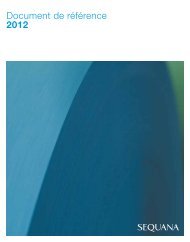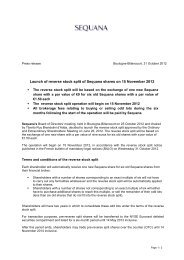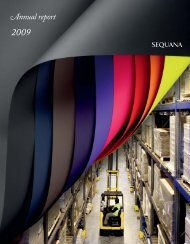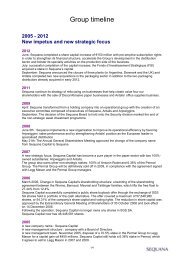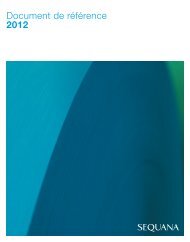Contents
Registration document PDF - Sequana
Registration document PDF - Sequana
Create successful ePaper yourself
Turn your PDF publications into a flip-book with our unique Google optimized e-Paper software.
6Corporate social responsibilityIn 2012, Sequana implemented a groupwide corporate socialresponsibility (CSR) policy aimed at bringing more consistencyto its efforts and stepping up its focus on key CSR challenges.The Group has chosen to base its 2012-2015 CSR policy on internationalstandard ISO 26000, which ensures that policies dulycover all aspects of corporate social responsibility.ISO 26000 was developed through global consensus and publishedby ISO/TMB, a working group on corporate social responsibilityset up by the International Organisation for Standardisation(ISO). ISO 26000 provides guidance on the principles underpinningcorporate social responsibility and provides and defineskey terms. It also covers stakeholder dialogue and the key issuesand areas where action can be taken. ISO 26000 also providesguidance on how businesses and organisations can operate in asocially responsible way. The standard is intended for use by alltypes of company and organisation. Although some sections ofISO 26000 are more relevant to certain companies than others,all core subjects must nevertheless be considered.ISO 26000 is based on 7 core subjects and 37 underlying issues:Organisational governanceHuman rightsLabour practicesEnvironmentFair operating practicesConsumer issuesCommunity involvement and developmentIn referring to ISO 26000, Sequana first considered which of the37 issues represented a key priority for a paper group. It then drewup a comprehensive list of the CSR initiatives in place within theGroup in light of these priorities. As a result of this analysis, eightareas for action were identified providing a focus for the Groupand a concrete guarantee that all relevant CSR issues would beduly taken into account. The following eight issues and the associatedaction plans therefore provide the basis for Sequana’s CSRpolicy over the period 2012-2015:■■Organisational governance: define a groupwide CSR policyencompassing all businesses and subsidiaries. The policy shouldset out commitments and objectives in each field and be basedaround a dedicated network of CSR correspondents and a transparentand reliable reporting system.■■Business ethics: introduce a code of conduct and clear internalpolicies to guarantee compliance with laws and regulations oncorruption and competition.■■Management and use of natural resources – product traceability:improve product traceability in order to reduce supply chainrisks; increase responsibly-sourced raw materials as a proportionof total raw materials used by the Group; and optimisewaste management to develop a circular economy.■■Energy management: review energy consumption processes inorder to improve energy efficiency and help develop renewableenergy sources.■■Water stewardship: manage water better in order to reducewater abstraction and improve wastewater quality.■■Working conditions: maintain a safe working environment toensure the health and safety of employees at work.■■Human resource development: step up the skills and knowledgedevelopment policy and protect diversity across the Group.■■Encourage customers to purchase sustainable products: reportresponsibly on the environmental performance of Group productsin order to advise and encourage customers to use productsand services meeting the highest environmental standards.By focusing on these issues and implementing the associatedaction plans, Sequana can ensure that its CSR policy considersthe impact of its activities – particularly its paper business – andthat CSR concerns are fully embedded in its governance, strategyand actions.The action plans apply to the entire Group, comprising the22 plants operated by Arjowiggins and Antalis’ 108 distributioncentres.To help readers, this chapter presents the Group’s commitments,initiatives and achievements based on the structure of ISO 26000and its seven core subjects. Readers are invited to consult theconcordance table on page 213 at the end of this chapter whichlinks the initiatives undertaken by Sequana to ISO 26000 andthe regulatory disclosures required by the Grenelle II Act. Socialand environmental indicators have been verified by ConstantinAssociés (a member of the Deloitte Touche Tohmatsu Limitednetwork), one of the Group’s statutory auditors, and are indicatedin the following chapter by the ✓ symbol.196 | Sequana | 2012 Document de référence (English version)




